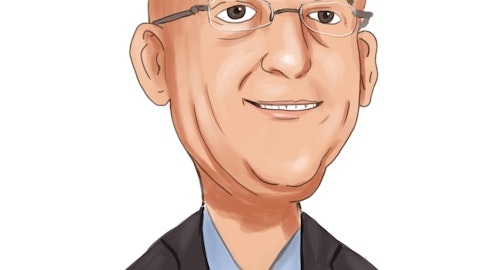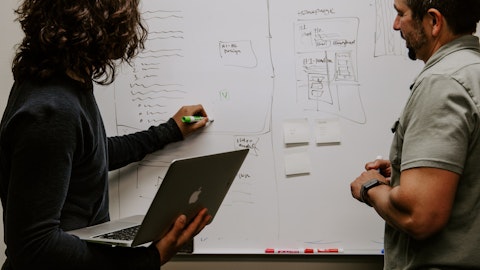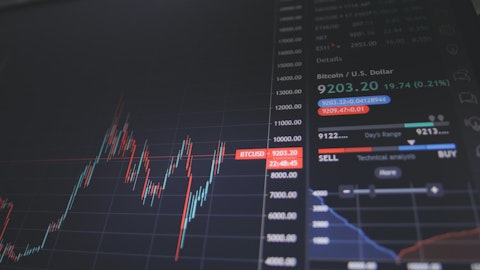Guess’, Inc. (NYSE:GES) Q3 2023 Earnings Call Transcript November 22, 2022
Guess’, Inc. misses on earnings expectations. Reported EPS is $0.44 EPS, expectations were $0.55.
Operator: Good day everyone and welcome to the Guess Third Quarter Fiscal 2023 Earnings Conference Call. I would like to turn the call over to Fabrice Benarouche, Vice President of Finance and Investor Relations.
Fabrice Benarouche: Thank you, operator. Good afternoon, everyone, and thank you for joining us today. On the call today with me are Carlos Alberini, Chief Executive Officer; and Dennis Secor, Interim Chief Financial Officer. During today’s call, the Company will be making forward-looking statements including comments regarding future plans, strategic initiatives, capital allocation and short and long-term outlook, including potential impacts from the coronavirus pandemic. The Company’s actual results may differ materially from current expectations based on, we expect those included in today’s press release and the Company’s quarterly and annual reports filed with the SEC. Comments will also reference certain non-GAAP or adjusted measures. GAAP reconciliations and descriptions of these measures can be found in today’s earnings release. Now. I will turn it over to Carlos.
Carlos Alberini: Thank you, Fabrice. Good afternoon, everyone, and thank you for joining us today. I am very pleased to report our third quarter results, which exceeded our expectations for revenues, adjusted operating profit and adjusted operating margin. Our performance continues to be impacted by the adverse currency environment due to the strong U.S. dollar. As a result, our revenues decreased by almost 2% in U.S. dollars during the period, while growing 10% in constant currency, driven primarily by the strength of our business in Europe. We delivered a 9.1% adjusted operating margin and $58 million in adjusted operating profit. Once again, Paul and I are very proud of our teams around the world, who continued to manage the business very effectively navigating through a challenging environment and growing market share in multiple markets.

Photo by Kelsey K on Unsplash
Our approach has not changed. We continued to focus on what we can control, paying close attention to inventories, which we continue to buy solely based on expected customer demand and managing costs tightly in spite of the current inflationary conditions, and our approach is working. Our Company continues to perform well in spite of theses non-controllable factors. We currently estimate that the impact of FX alone this year will contribute to a reduction of our operating profit of $60 million and to an EPS reduction of a $1.15 for the year. We are very proud of the work being done by our team. I want to commend our associates for the great work and outstanding contributions. Thank you, all, for your dedication to our Company. Starting with our performance by business, our Europe segment had a solid performance in the period, reporting a 2% revenue decline in U.S. dollars and a strong 17% increase in constant currency, driven by our wholesale and retail businesses, which continued to gain market share in a challenging environment.
Once again, the weaker euro had a significant impact on our quarterly results, contributing to a 19% decrease in operating profit for the segment in the period. Dennis will provide more color on this later in the call. Our Americas Retail segment reported a 2% revenue decline and a 53% decrease in operating profit due to gross margin contraction, coupled with an expense increase in the period. This performance was consistent with our expectations and reflected the comparison against strong results in last year’s third quarter due to unusually high levels of full price selling, resulting from high demand and low inventory levels. Our Americas Wholesale segment reported a 10% decline in revenues and a 41% decrease in operating profit, as we experienced increased order cancellations and higher customer accommodations, as retailers worked through their overall higher inventory levels.
Our Asia segment reported a 10% revenue increase in U.S. dollars and a 28% increase in constant currency, as we experienced favorable comps in many of our markets in the region given last year store closures or reduced activity due to COVID restrictions. During the period, we were able to breakeven in this segment, as a result of the revenue increase coupled with the gross margin expansion and effective expense management. Our Licensing segment had another solid performance this quarter, reporting a 4% revenue growth driven by strong performance of handbags. Regarding product performance, we continue to benefit from our global line of products across all categories, where product performance is very consistent across most global markets since we launched the global line.
While our business has historically capitalized on sales of denim products during the back-to-school season, this year, we saw a deceleration in sales of casual products and athleisure and a continued acceleration of sales of dressy products, as the customer is more focused on going out, traveling and socializing versus staying home. As a result, we delivered solid results with the dressy assortment within our collections including dresses from both Guess and Marciano. While our collections of sweaters and outerwear are very strong this season, we believe that the warmer than usual temperatures in both North America and Europe have impacted demand temporarily. We expect to see increased sales of these products during the upcoming months. Our sales of accessory products are growing faster than the rest of the business, and therefore increasing in penetration.
Strong product classifications here include handbags, travel accessories and small leather goods for women and men, eyewear, watches and fragrances. As we approach the end of our fiscal year, I want to spend a few minutes discussing how we are tracking against our strategic business plan. Today despite results of our efforts being masked by the current macroeconomic environment, including unprecedented currency headwinds, our Company and business model have been transformed. At the center of this transformation is our critical brand elevation initiative. As, you know, Paul and the product teams have done an incredible job transforming the product and have made significant progress over the last few years in elevating our brands. This work remains ongoing, as we continue to execute on our vision for the brands through our products, our images, our marketing, our stores and website and most importantly, our ability to deliver an outstanding customer experience.
Across the 25 product categories that we focus on, this team has significantly improved quality, including fabric strengths and make, reduced SKU development and increased productivity significantly. And this team has surgically priced every product based on its respective customer perceived value, which has enabled us to raise prices thoughtfully and drive AUR increases in our business last year and this year. We believe that the work that we have done also helps to differentiate our product and insulate us somewhat from that part of the market that may be overly reliant on heavy discounting to drive volume. The work that Paul and the product and creative teams have done truly represents the greatest transformation that we have embarked on at Guess in many years.
To support these product enhancements, we have also invested significantly in tools and infrastructure during the last three years and have improved our capabilities meaningfully to optimize data collection and reporting, customer engagement, segmentation, personalization, frequency of shopping and conversion. Regarding our digital transformation, we continue to make good progress on optimizing the new platform utilization and the implementation of our new CRM solution. We remain on track with a roll out of this suite in Europe by the end of this year, and now we expect its roll out in North America early next year. As planned, we just completed the development of a new clienteling app and are launching it in Europe, as we speak. And last but not least, we have updated our store fleet around the world meaningfully remodeling many stores and opening new locations, particularly in Europe and North America.
I will now touch on our supply chain initiative. As we have shared on previous calls, our strategy this year has been to order products earlier to mitigate the supply chain challenges that began last year. This strategy has served us well, as we have been able to meet our wholesale customers demand solidifying our relationship with them as a reliable partner. We delivered more products than we had anticipated in the quarter as, there has been considerable interest for early shipments from our customer-base in Europe. As we have said before, we continue to order product-based on anticipated customer demand. We have not been ordering more we have been ordering earlier. As we expected supply chains have recovering from last year’s disruptions and the product can now travel faster and arrive at destinations more in-line with the historical timelines.
We ended the quarter with 19% higher inventory levels than a year-ago, a deceleration from the second-quarter and we expect that gap to narrow further by the end-of-the year. Roughly half of the increase was due to earlier receipts and the other half due to cost increases as a result of investments in quality and sustainability, inflationary factors and the impact of currency. We are working on reducing production and transportation timelines for next year to tighten our inventory investment and increased turnover. With respect to freight costs, we are continuing to manage our model carefully with an eye on cost optimization. We have significantly reduced our air-freight usage this year resulting in meaningful cost reductions, thus far and we are also seeing some relief in ocean cargo rates, which has and will provide us with some modest benefits for the last quarter of this year.
Finally, I want to touch on our sustainability efforts. Sustainability remains a key focus for our brand, and we are committed to being part of the solution to climate change. In addition, to other work that we’re doing across the organization, we are pleased to have just completed our first new Upcycled Collection. This new line which we expect will be available in the first half of next year will exclusively use materials from recycled products that we collect in our stores and give new like to all products returned by customers. Now turning to our outlook for the fourth quarter, which remains largely unchanged from what we described during our last call. We expect softer consumer demand and inflationary forces to continue to impact our results this year and into next year.
We also sense that with the significant inventory levels being reported in this sector, we could see heightened promotional activity over the holidays, as companies seek to rightsize their inventories. Absent a weakening of the U.S. dollar, currencies will also remain a strong revenue and earnings headwind for us. As we normally do, we will focus on what we can control and we will adapt, but always with an eye on doing what is right for our brand long-term. All-in all we expect fourth quarter revenues to be down low to mid-single-digits in U.S. dollars and operating profit to exceed $100 million for the period. As it relates to fiscal year 2024 and beyond in line with our past practice, we expect to share our plans when we report our Q4 results in March of next year.
In closing, while there will always be work to be done, we are very happy with how we are positioned for the holiday period, as well as our ability to capture long-term growth opportunities. The transformation that we have been effective during the last three years, it’s clearly a game changer for our Company. We have two strong global brands, great products and a loyal customer base, who love the Guess and Marciano brands. Our powerful business model gives us a great platform to compete effectively all around the world. And our robust capital structure gives us the opportunity to invest and drive strong returns for our shareholders. We have a great team, who manages our business with discipline, controls the things that they can control and seeks and drives opportunities to gain market-share and deliver profitable growth.
Paul and I are so proud of this team of all their accomplishments and we couldn’t be more excited about our future. With that, I will pass it to Dennis to review the third quarter in more detail and provide more color about our outlook. Dennis?
See also 20 Companies That Sponsor H1B Visas and What Are the Most Valuable Brands in the World?.
Dennis Secor: Thank you, Carlos, and good afternoon, everyone. As Carlos described, our business and our teams performed well in the third quarter even a significant global headwinds persist. In constant currency we grew the top line by over 10%, though with the negative $76 million translation impact from the strong U.S. dollar. our reported U.S. dollar revenues declined almost 2% to $633 million. Even against the backdrop of persistent global inflation and softening economic sentiment, we continue to benefit from our diversified business model with some regions continuing to post strong results, while in other areas of the business, our goal is to improve our performance. Especially satisfying too is that the substantial majority of our revenue growth is organic, meaning it is high-quality, strong return levered growth, driven by higher demand from our wholesale partners plus same-store sales growth, productivity gains from our existing retail store investments.
We feel that reflects positively on the strength and momentum of the brand in many of our markets. In Europe, we continued with strong momentum, as the European consumer continues to reemerge after the pandemic. Demand from our European wholesale partners remained strong, and in our retail stores there, higher traffic and AUR increases helped deliver strong constant currency comps. Our retail stores in Canada and South Korea followed a similar pattern to Europe both delivering positive constant currency comps for the quarter. These areas of regional strength helped mitigate some softening in the U.S., where we’re lapping last year’s strong post pandemic demand. We’ve also experienced headwinds in global e-com, as consumers are shopping more intensely in-stores and in China, COVID restrictions are still affecting commercial activity.
On top of all this the U.S. dollar remained very strong against all major currencies and continued to be the most significant headwind for our margin performance, 180 basis points equal to our total adjusted operating margin decline. So let me drill down into our performance. In Europe, the underlying dynamics of our business in the region remains solid even as inflation, energy shortages and negative economic sentiment affect consumers in the region. Overall revenues in Europe grew 17% in constant currencies, though they declined 2% in U.S. dollars. Revenue growth for the segment was driven primarily by higher wholesale shipments, a strong constant currency comp-store sales increase and new stores that have been added in the region over the last 12 months.
These growth drivers were more than offset by the negative impact of currency. Just as with last quarter, we and our wholesale partners benefited again from our proactive management of inventory, where we’ve accelerated product deliveries to mitigate supply chain delays. Our shipments this quarter include about $8 million in deliveries that we had expected would be shipped in Q4. In our European retail stores, we continued to see strong traffic into our stores, though that growth rate moderated somewhat compared to our most recent quarters, as we have now anniversaried some of the easing of COVID restrictions that took place last year. We continue to enjoy strong AUR growth given our price increases over the last year, while conversion was still negative though eased from the second quarter.
This resulted in a 15% constant currency comp increase for the quarter. One further note on comps relates to Turkey, where the economy is experiencing hyperinflation, that’s creating an outsized impact on our constant currency comps. If we exclude Turkey our European store constant currency comp increase would have been 7%. European operating earnings decreased 19% and the operating margin declined by 230 basis points due to lower gross margins, mainly caused by the strong U.S. dollar, partially offset by a lower expense rate due to leverage. In Americas Retail, revenues decreased 2% in U.S. dollars and 1% in constant currency. Revenues benefited from the operation of new stores opened over the last year, which was more than offset by permanent store closures.
Comp store sales were flat in constant currency. In the quarter, our comp performance was driven by increases in both AURs and traffic, offset by lower conversion. Again, this quarter our tourist locations outperformed the rest of our store fleet, as the U.S. returns to a more normalized level of travel after the pandemic. Americas Retail operating profit declined 53% and operating margin declined 730 basis points. The change in margin was driven by a higher IMU, more than offset by a lower mix of full price selling, higher expenses, including store selling expenses, given pressures on labor costs and a lower level of COVID relief this year. In Americas Wholesale, revenues declined by 10% in U.S. dollars and 9% in constant currency, as some U.S. wholesale partners are managing their own inventory levels by limiting their receipts.
Operating profit declined 41% and operating margin declined 10.1 points, mainly due to product margin declines from increased customer accommodations and higher expenses. In Asia, revenue grew 10% in U.S. dollars and 28% in constant currency. The primary drivers for our sales growth included the direct operation of some of our South Korea retail stores, which we acquired from one of our wholesale partners, sales growth from our ecommerce business along with the constant currency comp increase of 11% from the regions retail stores. While traffic continued to be down compared to a year ago, strong improvements in conversion and a higher AUR drove the comp growth. These increases were partially offset by permanent store closures in the region.
The region posted a breakeven operating result, a $2 million improvement from last year. And finally in our Licensing segment, royalty revenues increased 4%, driven mainly by a strong increase in global selling of handbags. Segment operating profit was $25 million, a slight increase from last year. In the quarter, total Company gross margin contracted 320 basis points to 42.5%, about half of which was driven by currency headwinds. Also affecting gross margin was a higher mix of markdowns this quarter compared to last year, given last year’s inventory scarcity. Adjusted SG&A for the third quarter declined 5% to $211 million including a favorable currency impact of $23 million compared to last year’s expense level. In addition to that currency impact, performance-based compensation accruals were significantly lower this year given last year’s extremely strong performance against operating goals.
Partially offsetting these expense reductions were higher store selling expenses given net new store growth since last year, as well as labor cost pressures. We also invested in additional variable expenses to support our wholesale growth. For the quarter, our adjusted SG&A rate improved 130 basis points to 33.4%. Our third quarter adjusted operating profit was $58 million, 18% lower than last year, and our adjusted operating margin was 9.1%, a 180 basis points lower than last Q3. In the quarter, we recorded non-operating net charges of $15 million. These charges relate to the re-evaluation of certain of our foreign subsidiaries net assets and liabilities into U.S. dollars and the net charges to mark our deferred compensation plan and SERP plan assets to market.
Our third quarter adjusted tax rate was 30%, up modestly from last Q3’s rate of 27%. Adjusted EPS in the quarter was $0.44 per share versus last Q3’s $0.62. Moving now to the balance sheet. We ended the third quarter with $170 million in cash compared to $391 million a year-ago. Our year-over-year cash position was impacted significantly by the $238 million of share repurchases executed in the last 12 months. We ended the quarter with a total of $270 million of borrowing availability on our various global facilities. We made no open market share repurchases during the quarter, leaving our remaining share repurchase authorization at $62 million. Inventories were $575 million, up 19% in U.S. dollars and 33% in constant currency versus last year.
As Carlos mentioned, our additional inventory investment primarily reflects our strategy to order earlier this year to protect our business and support our partners, as well as higher average unit costs reflecting our investments in quality and sustainability and inflationary pressures. As the supply chains appear to be recovering, we expect to return to a more traditional receipt plan and that this growth rate will moderate over the next few quarters. Our receivables were $319 million, a 1% decrease versus last year’s $321 million. On a constant currency basis, receivables increased about 14%. For the first three quarters of this year, capital expenditures were $72 million, up from $41 million in the prior year, mainly driven by investments in remodels, new stores and technology.
In one pose Q3 development, this month, our Russian minority interest partner exercised his put option related to a 30% interest in our Russian entity, where our business is profitable and has been performing well. We have reviewed the various economic sanctions on Russia and have concluded that our pre-sanction obligation to purchase the interest is not prohibited by the sanctions. Therefore, we expect to be able to proceed with the transaction, which we currently expect to take place by the end of the first quarter of next year. Free cash flow for the first three quarters of this year reflects a net investment of $98 million versus $41 million in the prior year, the change being mainly driven by this year inventory acceleration, lower net cash earnings and higher capital spending, offset by last year’s impact of the tax payment made associated with our IP transfer to Europe.
Today, we also announced that our Board approved our quarterly dividend of $0.225, which at recent stock prices represents an annual yield over 4.5%. So now, let’s talk about our fourth quarter outlook and how it will impact our full year. Overall, our operating expectations for the balance of the year remained largely unchanged. We expect areas of momentum such as, Europe, Canada and South Korea to continue, where demand for the brand has been strong with traffic to our stores increasing and higher AURs. In the U.S. we expect that traffic patterns there will also continue and that consumers will remain more price sensitive with the effects of inflation affecting their spending habits. We are planning, assuming that currencies remain at roughly prevailing levels, which will weigh even further on this year’s results.
Most of that further headwind materialize already in the third quarter most significantly with a large non-operating mark-to-market charge, but currencies also further negatively impacted our third quarter operating margin. For the full year, we are adjusting our adjusted EPS outlook downward by $0.30 most of which relates to currencies, plus the Q3 mark-to-market charge we recorded for our deferred comp and SERP plans. The modest reduction to our full year adjusted operating margin outlook reflects the impact of currencies and an expectation that other company’s inventory levels may result in a more promotional environment. Therefore, for the full year, we are now expecting revenue growth of nearly 2% in U.S. dollars and about 10.5% in constant currency.
We expect full year operating margin of about 9.7% and full year adjusted EPS of $2.35. For the fourth quarter, we assume U.S. dollar sales to decline about 3.5%, but increase 3.5% in constant currency. We expect fourth quarter operating margin of about 13.2% and adjusted EPS of $1.32. Lastly, I want to again highlight the impact of currencies on this year’s financial outlook. Based on our assumptions, currencies will consume almost nine points of revenue growth, almost $230 million. They will further consume about 130 basis points of adjusted operating margin and $60 million of adjusted operating profit. If we were to eliminate all of that, all other things being equal, our full year outlook would have instead been for sales growth of 10.5% to reach well over $2.8 billion, adjusted operating margin of around 11% and adjusted operating profit growth to exceed last year’s $310 million.
And combining this year’s currency mark-to-market charges with the $60 million operating profit headwind, the total currency impact would approach $1.15 per share. To reinforce Carlos’ point, we are proud that in this challenging macroeconomic environment, we are delivering outstanding results. Unfortunately, those results are being severely masked by so much currency noise. With that I’ll conclude the Company’s remarks, and let’s open up the call for your questions.
Q&A Session
Follow Guess Inc (NYSE:GES)
Follow Guess Inc (NYSE:GES)
Operator: Thank you. We will now begin the question-and-answer session. Our first question comes from Corey Tarlowe from Jeffries and Company. Your line is now open.
Corey Tarlowe: Hi, good afternoon, and thanks for taking my questions. So Carlos, it seems like the demand for the brand has been really strong with absent any FX issues really robust growth. So maybe could you just, talk about how the consumer is responding to some of the newness that you’re flowing into stores, what some of the inventory turns are looking like and how the general sentiment is for the brand now versus maybe where we were in — at the beginning of the year. And then just to piggyback off of that, how do you think about the promotional environment as well as we look to the fourth quarter.
Carlos Alberini: Okay. Thank you, Corey, yes. Yes. I think that what you’re saying, it’s absolutely the case. We feel that the demand for the brand continues to strengthen and I should say, the brands because we are seeing also significant commitment to the Marciano product as well, in addition to Guess. As you know, we have a very strong business in wholesale, especially in Europe and this business is always a good benchmark for how the different collections are being accepted and embraced by our customer base because that best of clients and customers is very diverse. We have several thousand accounts and normally that is a very good indicator of how the product is being accepted. And we have seen consecutive growth season after season in that business and the customers continue to want more of that product being shipped earlier if possible, that allowed us to really increase our shipments this quarter.
And we feel that, that is all being driven by what they see in their sell out, so it’s not just about ordering more product, but how the product is selling to the ultimate customers in their points of distribution. So we feel very good. And then, of course, we have a major presence with our retail stores and this includes not only what we see in Europe, but all over the world. We have over 1,000 doors, as you know that we control directly and about almost 700 that are in the hands of franchisees, licensees, partners of ours. And in those cases, of course, the behavior of the customer now considering how the different territories have evolved after the pandemic is somewhat different depending on where you are in the world, but we are seeing that the product is being very well accepted.
We have a big difference in the performance of the type of product that we have in the collections. As you know, we are a lifestyle brand, and we can go from casual to dressy, which is something that we think is a huge benefit and a big differentiator in this marketplace. And what we are seeing is that the dressy product is selling significantly better and accelerating versus what we’re seeing with more of the casual part of the assortment. But that said, just we are very pleased with how the overall collection has been accepted both for men and women and Guess and Marciano. And then just the one area that has been very strong for us and continues to be very strong and accelerating also is accessories. You know –as you know, accessories is a big part of our collection and we are seeing phenomenal outstanding performance with accessories especially driven by handbags, but many other accessories items, as I mentioned in my prepared remarks are also doing very well.





